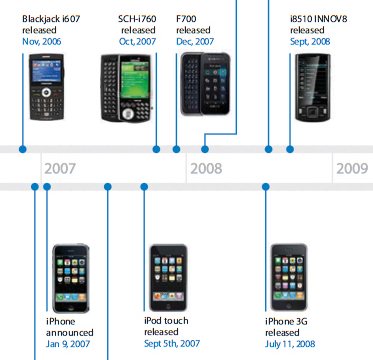Apple vs. Samsung
The trial in San Jose, California, was won by Google, but the jury's statements are surprising.
In April 2011, Apple recovered $2.5 billion from Samsung in damages. The trial began in July 2012. By copying our products, the company brazenly claims, Samsung was able to make huge profits. Choosing a court on Apple's home turf, in a population thriving on new technology, puts Apple in a prime position.

According to Samsung:
In fact, Apple, which sold its first iPhone twenty years after Samsung began developing mobile technology, could not sell a single iPhone without Samsung's patented technology.
Apple charges $24 for a Samsung phone for its rounded rectangle patents, but denies Samsung's right to claim more than half a cent for all patents required to operate a mobile phone it has owned since the 1990s! Including patents 7,447,516 and 7,675,941 for 3G, which are used by the iPhone.
Apple seems to think that the more outrageous it is, the more likely it is to succeed!
The South Korean company also claims that iPhone concepts were in the public domain and have already been used by Sony, among others. The documents circulating at Apple acknowledge that Apple's strength lies not in developing new products but in knowing how to sell them.
During this trial, it was discovered that the design of the iPhone was actually created by a Sony employee, as explained in the article on the origin of the iPhone, but Apple denies this.
On August 24, 2012, the jury found that Samsung used Apple's patents exclusively for the design of the iPhone 3G (for the Galaxy S), the '381 patent for bouncing while viewing a document, and other similar "inventions." The jury found that the Samsung tablet did not copy Apple's design .

Comparison of Galaxy Tab 10.1 (2011), iPad (2010) and CrunchPad (2009)
It does not provide Samsung with any compensation for Apple's violation of the five most important patents based on the "patent exhaustion doctrine." Samsung allegedly implicitly allowed Apple to use them.
But it awards Apple $1.49 billion for user interface patents!
It looks like the jury acted hastily, awarding $219,000 in damages for the design of the Galaxy Tab 10.1, although it ruled that it did not copy the design of the iPad! The sentence had to be corrected. This and other inconsistencies could affect the appeal process. In addition, the fact that the jury master himself has a software patent (No. 7 352 953) and led to the fact that he did not consider the prior art.
As can be seen from the interview he gave, having found that the prior art does not work on the same processor, it should not be considered, which is not in accordance with patent law.
No, there is nothing wrong with the older prior art (sic) - but the key is that the hardware was different, the software was a completely different methodology, and the more modern software could not be loaded into the older example and run without errors. (BBC source)
And not significantly, when we looked at the source code - I was able to read the source code - I showed the jury that the two methods in the software were not the same.
But the processor is not indicated in the patent. It seems that the jury confused the invention with its implementation. The code is copyrighted; patents are something else.
Then, when asked if he studied the validity of patents, he replied:
No, it isn't. Still, it's not the jury's role to examine it. The judge asked us not to challenge the current patent system.
In contrast, juries must always judge the validity of a patent before deciding whether it has been infringed or not, and jury instructions explain this in detail (29-33 and 46-52).
And it turns out that the pinch-to-zoom patent 7,844,915, one of five Samsung is being condemned for, was invalided.concudited by the USPTO in December 2012 because it was similar to an earlier patent 7,724,242.
This principle has actually already been used on Microsoft's PixelSense touchscreen (conceived in 2001), but Apple believes that it is becoming a new invention on a mobile phone.
The instructions do mention (p. 40) the concept of implementation, but in connection with patent infringement rather than prior art. It's as if the jury, although not considering the concept of prior art, have read the instructions superficially and picked up this sentence on the fly!
The foreman of the jury adds that if he were not there, the jury would certainly have come to completely different conclusions, and, seeing how erroneous his ideas are, we can conclude that the outcome of the trial is completely biased!
Finally, we learned that Mr. Hogan did not mention the fact: he was actually previously sued by a company owned by Samsung (Seagate), which led to his bankruptcy. Had he mentioned it, he would have been removed from the jury.
Apple then accused Samsung of knowing about the fact and not mentioning it in order to get the court invalidated. To which Samsung replied: "Did you, did you know that?" Since Apple was forced to answer in the negative, its argument fell flat!
22 Oct 2012
The USPTO began to invalidate patent 7,469,381, which became one of the grounds for Samsung's condemnation. This patent, relating to scrolling through a list on a touchscreen, was deemed unoriginal. It may also invalidate the decision.
17 Dec 2012
The judge denied Samsung's request for a new trial on the grounds that the juror's statements to the press would not be admissible in court, regardless of what they might reveal.
March 1, 2013
The same judge said the jury failed to comply with the court's directions, that the damages were based on a false theory, and therefore reduced the amount by $450 million. She recommended holding a new trial, but after the appeal hearings.
21 Nov 2013
The jury in this new trial awarded Apple $290 million. This was for five patents, one of which was invalidated by the USPTO. The appeal will allow the case to be reviewed on the merits, since this new trial concerns only the amount of damage.
On December 9, 2013, Apple announced that it had spent $60 million on legal fees and asked to oblige Samsung to pay a quarter of this amount. In other words, she has to pay for the stick she was used with.
Reference: Apple Inc. v. Samsung Electronics Co. Ltd., U.S. District Court, Northern District of California (San Jose).
02 May 2014
A federal jury ordered Samsung to pay $119.6 million for two patents (Apple sought $2.2 billion), and also ordered Apple to pay $158,400 for a patent that is considered to be used in good faith. That's a far cry from the billion dollars awarded in the original trial.
18 May 2015
The Federal Circuit Court of Appeals reversed part of the decision, finding that Samsung did not violate Apple's intellectual property rights regarding the appearance of their mobile phone (a rounded rectangle). The amount of damage should be reduced.
14 Oct 2015
Apple was found guilty of violating the University of Wisconsin patent 5,781,752 in the development of its processors. The university also sued Intel, but was eventually settled in 2009, paying a $110 million license fee. The Apple A7 processor, which uses patented technology, dates back to September 2013, and the lawsuit was filed in 2014. Apparently, Apple's lawyers were too focused on Samsung copying pseudo-inventions on the interface to handle the Intel case. Apple was ordered to pay $234 million.
As of December 4, 2015
Samsung agreed to pay Apple $548 million, but reserved the right to seek a refund if the USPTO upholds the invalidation of the '915 patent or if the Supreme Court overturns the decision.
February 26, 2016
Apple won a second lawsuit against Samsung for using patents 5,946,647, 8,074,172, 8,046,721 and two others. The court found that Samsung did not infringe on the other two patents. Samsung was ordered to pay Apple $ 119 625 000 .
A federal appeals court in California reversed that decision.
As for patent 5,946,647, it claims that Apple has not proven that Samsung violated the patent, which is to convert a number into a clickable link using a parser server.
As for patent 8,046,721, a slide to unlock, a rusting device (what an invention!), The court invalidated it because it had a prior art. Microsoft's Neonode N1 used this principle before Apple. And the principle was described in a lecture given by Catherine Pleasant in 1992.
As for the self-correction patent 8,074,172, it was also invalidated for the prior art because another patent 7,880,730 describes the principle (USPTO does not even refer to its own archives!).
In conclusion, Samsung owes Apple nothing, but Apple remains convicted of infringing Samsung's patent, 5,579,239. The tables are turned .
December 6, 2016
A lawsuit filed by Apple (Steve Jobs) in 2011 for violating its patents on the design of the iPhone (a rectangular device with rounded corners) led to Samsung being ordered to pay $1 billion in damages, later reduced to $400 million. Today, the Supreme Court reversed that decision, ruling that damages could not be assessed on the basis of the entire product, but only on a fraction of the elements copied.
So, it's back to the Federal Circuit Court to reassess the damages.
July 27, 2017
In another lawsuit, Apple was ordered to pay $506 million to the University of Wisconsin for violating patent 5,781,752 regarding the design of its microprocessors. Apple will appeal, but it is the only one to sue for that patent, while other manufacturers have either paid for the license or reached a compensation agreement. Everyone copies everyone else, but only one company refuses to admit it.
November 6, 2017
In the last and final lawsuit, Samsung was ordered to pay Apple €120 million. This applies to patent 5946647 for a system that forces a computer to perform an action on a data structure, and patent 8046721, which allows you to reactivate a smartphone by swiping your finger over a cursor on the screen. The second patent was declared invalid by the court, but the court of appeal refused to consider it .
After the Supreme Court refused to hear the case, the judgment is now final. However, this is far from the billion that was originally awarded to Apple.
Therefore, the jury ordered Samsung to pay Apple $539 million (which it would not be difficult for it to beat off from the prices of the components it sells to Apple), after which the two companies agreed to settle without disclosing the terms of the agreement (it is assumed that Samsung promises not to raise its prices).
Apple patents:
5,946,647 Quick-links. Performing an action on a structure (1999). In this case, convert the phone number to an address.
8,074,172
Word recommendation.
8,046,721 Slide to unlock on some models. Activate the device using a gesture in the unlock image.
Samsung patent:
5579239 Video transmission by signal compression.
We see that Apple's patents are nonsense; Samsung seems more consistent.
Apple design patents affected by regulation 6/12/2016:
D618677 Black rectangle with rounded corners.
D593087: With the border surrounding the case.
D604305: Grid of 16 color icons.
Dirty tricks from Samsung against HTC?
Tawain

